Without scales in the kitchen: how many products are in a glass, a tablespoon and a teaspoon. How to quickly measure ingredients without a scale.
When there are no scales in the kitchen, modern housewives often panic. How can you cook anything without them? Is it completely unrealistic to make seaming without weights? pastry art, delicious meat and even cereals to fall asleep according to the recipe in a slow cooker. But after all, our grandmothers and great-grandmothers did an excellent job without scales in the kitchen, and this does not mean at all that their eye was perfect, unlike our “sight”. Simply put, every hostess in the kitchen had a record of kitchen measures and weights.
We have compiled this article for those who want or have to do without weights, and at the same time cook delicious recipes.
How many GRAM and ml in one faceted glass?
As we know from school lessons, all liquids and solid foods have different weights with the same volume. To cook according to the recipe, it is enough to have a glass, a glass, tablespoons and teaspoons at hand.
Note that the calculation is taken in a 200 g glass. To find out the volume of a glass / shot glass, take a measuring glass and check with water, or type in liter jar water and pour into a glass. A liter of water should make 5 glasses. You can also find out the volume of a glass using a 200 g glass.
Below we provide a table that details the main components.
There are also popular products that are not included in this wonderful table, but are so in demand in our kitchens.
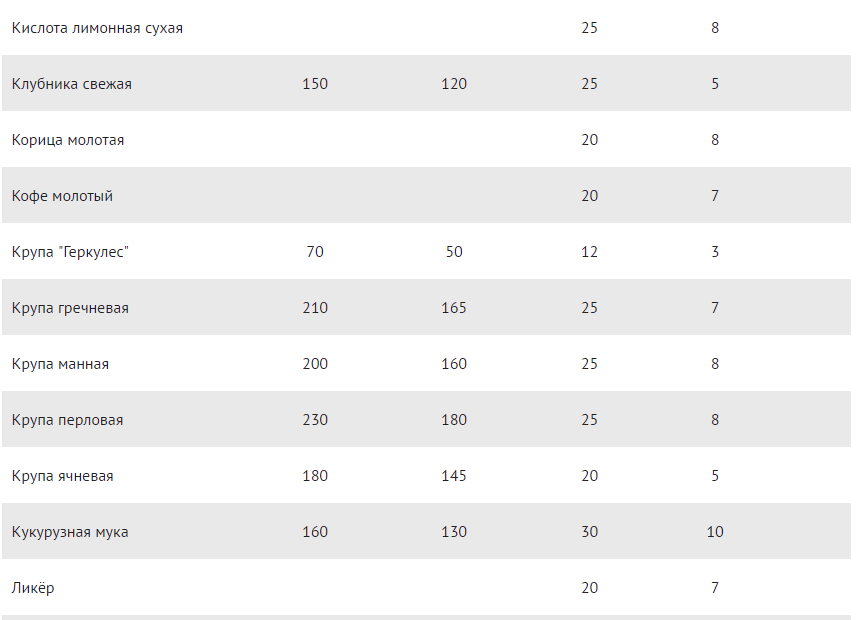
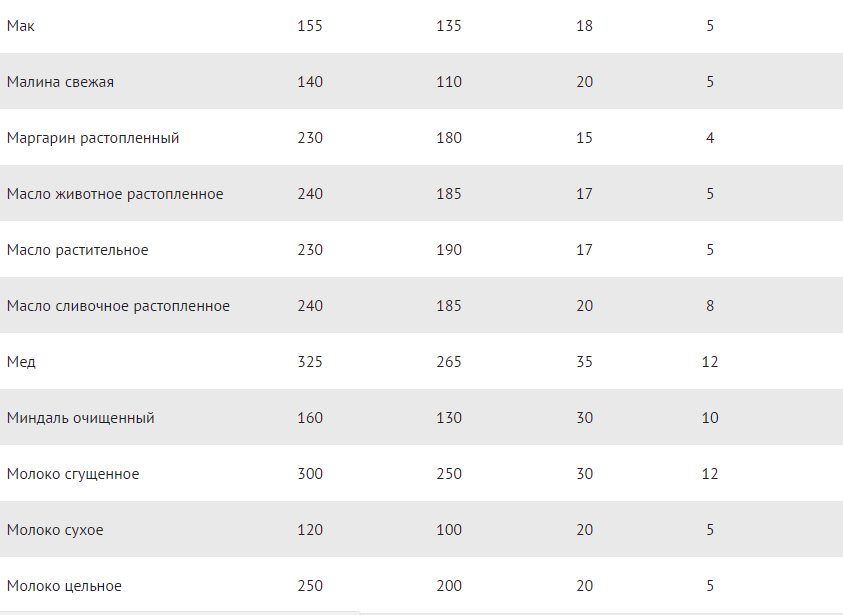
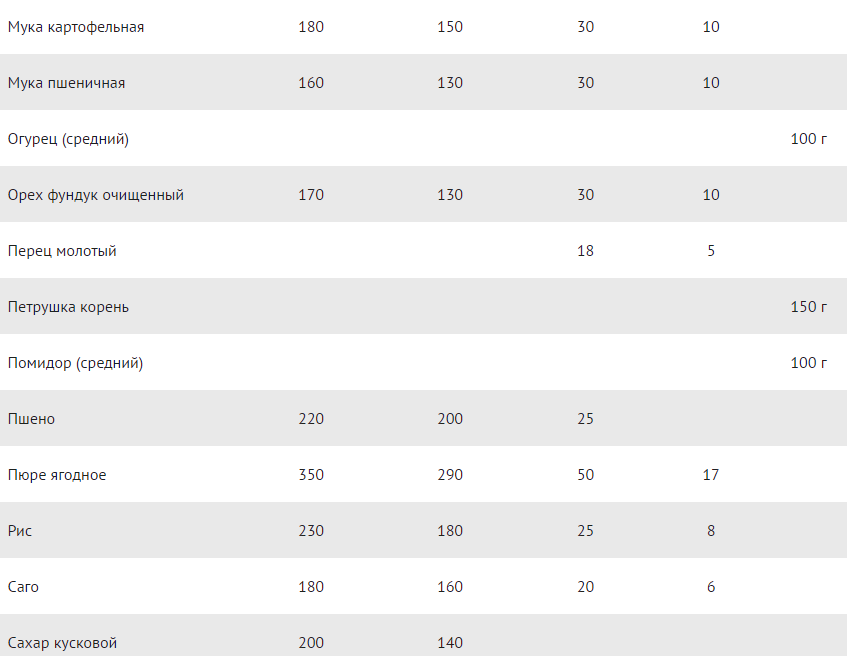
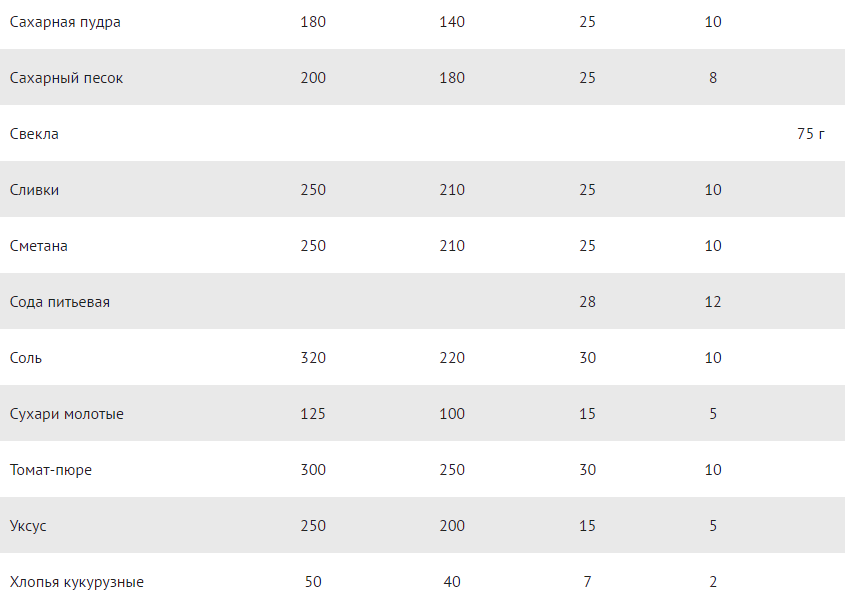
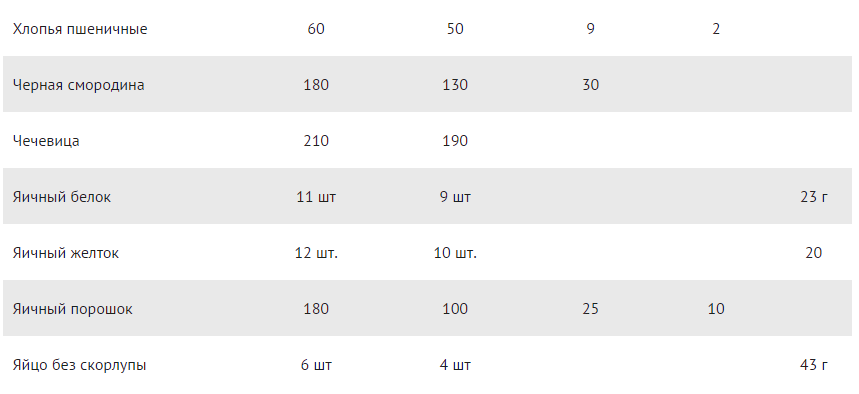
So, in one 200 gram glass:
- Kefir - 200 gr.
- Cottage cheese - 220-280 gr. (depending on the fat content, moisture content of the curd)
- Mayonnaise - 200 gr.
- Starch - 130 gr
How many grams and ml in one tablespoon?
These same products are often used in smaller proportions. So, in one tablespoon:
- Kefir - 18 gr
- Cottage cheese - 17 gr
- Mayonnaise - 15 gr
- Starch - 12 gr
- Dry yeast - 8 gr
- Cocoa - 15 gr
How many grams and ml in one teaspoon?
- Kefir - 5 gr
- Curd - 6 gr
- Mayonnaise - 4 gr
- Starch - 6 gr
- Dry yeast - 3 gr
- Cocoa - 5 gr
Another important issue for cooks and cooks is the proportionality of a glass, a teaspoon and a tablespoon.
In a faceted 200 g glass, 10-12 tablespoons without a slide and up to 40 teaspoons of liquid or bulk products can be placed.
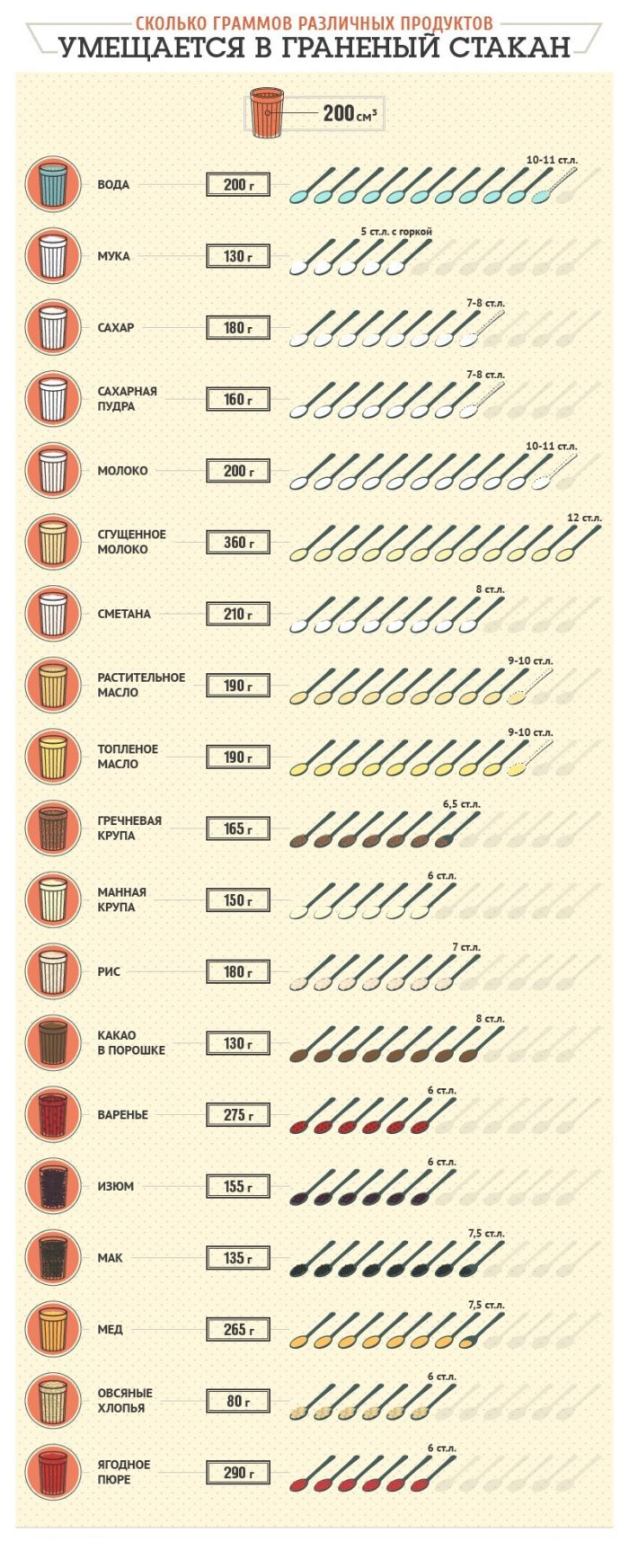
It is worth noting that in most professional recipes only large portions are considered. For convenient crushing, it is sometimes useful to know that 3-3.5 teaspoons fit in one tablespoon.
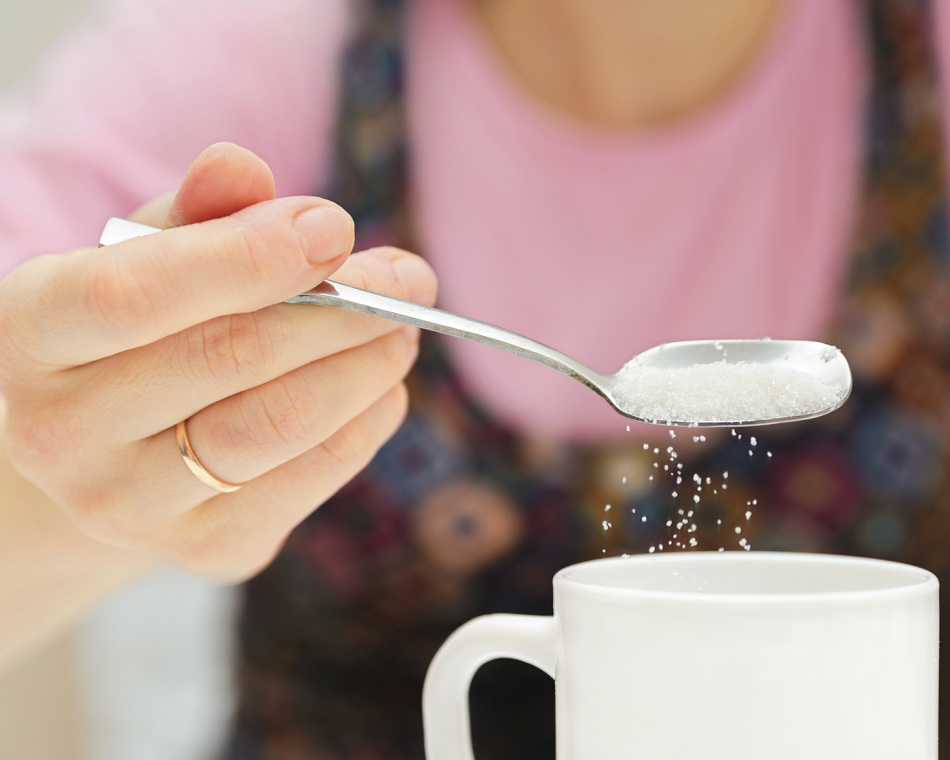
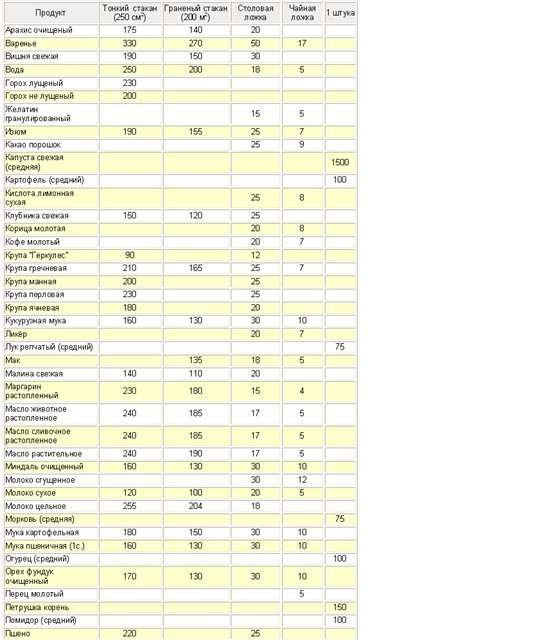
Table of kitchen measures, weights and volumes of products in grams, spoons, milliliters for liquid products and water
Majority liquid products are present in the tables above. In this section, we will only supplement with a table of standard volumes, which will certainly come in handy in culinary calculations.
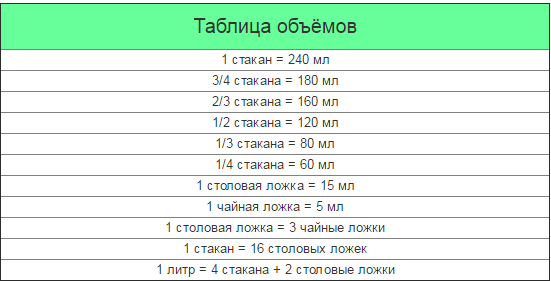
Video: Table of Measures of Products in Grams
What determines the taste of food? “On the quality of the products and the skills of the cook,” you answer, and you will, of course, be right. But there is another important aspect of preparation - correct ratio components. To do this, you need to know different ways to measure weight, volume, including how many milliliters are in a tablespoon - the most popular home gadget.
The spoon is one, but the volume is different
In cooking, it is customary to indicate the amount of ingredients in milliliters. But not everyone in the kitchen has accurate measuring instruments. But everyone has a tablespoon. And, despite the fact that this cutlery is different shapes, its volume remains the standard measure for products.
Before talking about how many milliliters of different liquids are in a tablespoon, it is worth noting that fluid products, unlike dry ones, are easier to measure due to the fact that they cannot be collected with a slide. In addition, the volume of liquids is almost always equal to their weight. Let's remember the school physics course: 1 cubic meter of water is equal to 1 kg. If you need to determine how many milliliters of water are in a tablespoon, then you should remember the answer - 16 ml. But there are liquids that are more viscous or denser in structure - what about them? To do this, there are volume standards for different fluid products.
How to determine the volume of a spoon?
![]()
Finding the number of milliliters in a tablespoon for different products is not difficult, but how to determine the volume of your device is a question. A question, but not a problem! As mentioned above, the volume standard is calculated with water. To determine how your spoon matches this very sample, pour water into it, and then draw it into a syringe - that's the exact amount of the most important liquid for a person. By the way, according to these measurements, tablespoons are divided into three types:
- European and American - their capacity is 16 ml;
- English - 18 ml;
- Australian - 20 ml.
Oil and syrup
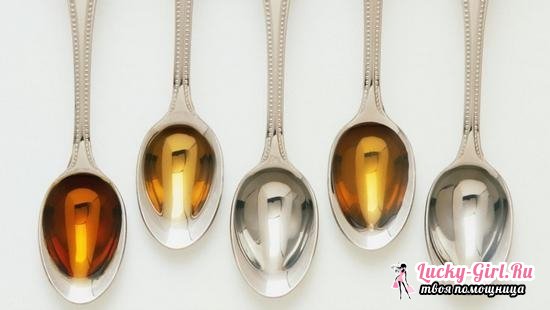
Imagine that you decide to cook some intricate recipe taken from a cookbook by French chef Paul Bocuse. And what? The world-famous Michelin star points out that, for example, vegetable oil you will need 40 ml. So, if your kitchen does not have accurate measuring devices, then the idea will have to be abandoned? Not at all. You just need to calculate how many milliliters of vegetable oil in a tablespoon. The standard volume of this product for such cutlery- 16 ml. So, Bocuse recommends adding 2.5 tbsp. l. product. And what about syrup? How much of this liquid does a tablespoon contain? As much as water, oil, milk and vinegar, that is, all the same 16 ml.
Thick liquids
![]()
If you need to add condensed milk or tomato paste to prepare a dish, then a difficulty of this nature arises: these mixtures can be scooped up with a slide, moreover, most likely, this is exactly what will happen. Therefore, it is important not only to know how many milliliters of this or that thick product contains 1 tablespoon, but also to try to collect it flush with the edges.
And then again the reference table comes to the rescue. So, in 1 st. l. 17 ml condensed milk and 18 ml tomato paste. Honey in a tablespoon will also fit 18 ml. But with sour cream, things are a little more complicated. If the product is store-bought, then 1 tbsp. l. will equal 18 ml, and if homemade, then 20 ml. Also, care must be taken with regard to the butter. 1 st. l. contains 18 ml, but if the butter in a tablespoon is slightly melted, then answer exactly how many milliliters it will be dairy product, difficult, you can only specify approximately - 19-21 ml.
As you know, accuracy is the courtesy of kings. But sooner or later there comes a moment when mere mortals have to be scrupulous to the smallest detail, or rather, to milliliters. Suppose an infant needs to be given 5 ml of syrup, and an error of even 1 ml is unacceptable. Mom can easily cope with this if she knows how many milliliters are in a teaspoon. Let's learn how to measure!
Nothing superfluous: what you really need to know about milliliters
The milliliter is a popular unit that has been used to measure liquids for over three centuries. It is found not only in cookbooks, but also in the instructions for medicines. But how to measure the indicated number of products or medicinal product? The easiest way to do this is with a spoon.
- 1 dessert spoon- 10 ml (since it is twice as large as tea);
- 1 tablespoon - 15 ml (its volume is equivalent to 3 tsp);
- 1 cup - 200 ml (40 tsp).
So, if you need a strictly metered amount of a liquid substance, then you can easily measure it with standard teaspoons: 1 tsp. - 5 ml. But this will be correct if two conditions are met: the amount is indicated precisely in milliliters, the measured liquid in its consistency corresponds to ordinary water.
Read also:
- How to measure 100 grams of sugar?
Having learned how many milliliters of water are in a teaspoon, many will doubt the accuracy of such a measurement. After all, a liquid whose density does not coincide with the density of water will have a different volume. This is quite fair, so it does not hurt to know how many different liquid products this kitchen appliance can hold.
Are you measuring liquids correctly?
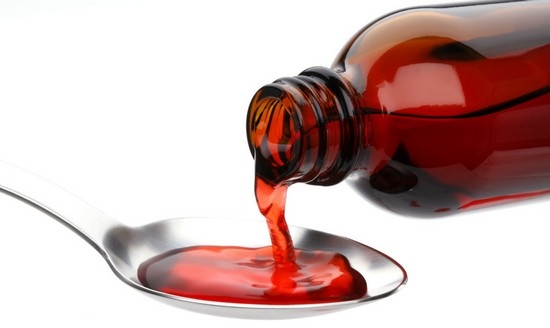
Of course, you can measure a portion of the liquid with a measuring cup with divisions. But it is much easier to do this with a spoon, especially since everyone has it.
When you start measuring out medicines or foods for meals, keep in mind that the volume and weight that 1 teaspoon holds (in other words, how many milliliters and grams) can vary dramatically. Weight is directly determined by density: the higher this parameter, the heavier the substance.
Let's get down to business. The volume of different liquids in 1 tsp. such:
- water, table vinegar, medicinal syrup, wine, vodka - 5 ml (or 5 g);
- vegetable oil - 4.9 ml (4.53 g);
- olive oil - 4.93 ml (4.49 g);
- milk - 4.9 ml (5 g);
- condensed milk - 9.3 ml (12 g);
- sour cream - 4.7 ml (5 g);
- cream - 5 ml (10 g);
- jam - 6.6 ml (17 g);
- melted margarine - 4.6 ml (4 g);
- melted butter - 4.8 ml (5 g);
- mayonnaise - 5 ml (4.16 g);
- honey (thick) - 9.2 ml (12 g); liquid - 4.93 ml (6.4 g);
- fruit puree - 7 ml (17 g);
- tomato paste - 6 ml (10 g);
- liquor - 4.93 ml (5.47 g).
We have collected the most common products liquid consistency found in recipes. But what if you come across some exotic ingredient? How to deal with weight and volume? Read on!
How, without knowing physics, is it easy to convert milliliters to grams?
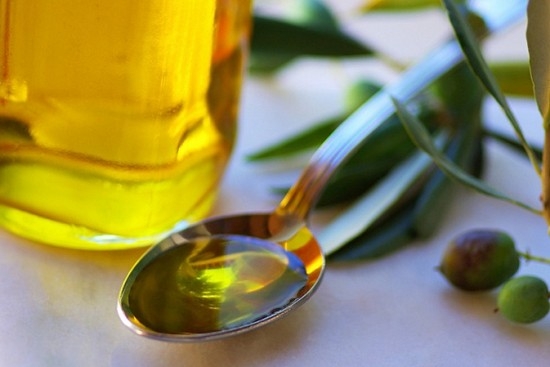
If everything is done according to the rules, then to convert milliliters to milligrams, you need to arm yourself with a calculator, pharmacy scales and a density table of substances. There is also a special formula: multiply milligrams by the density of a substance and divide the result by 1000. Are you already bored?
Then just take note of this information: a milliliter (ml) and a milligram (mg) are not the same thing! 1 ml = 1000 mg. How to put it into practice? If it is indicated that you need to take 5 ml, for example, vegetable oil, then in terms of mg it will be 5000 mg (about 1 tsp) Did you feel the difference? Try not to get confused about these measures, as confusion about units can lead to big problems.
But the difficulties of translation do not end there. If you just add zeros, then the answer will be wrong. Use this quick translation tactic for some culinary products:
- 1 ml will be equal to 1 g for water (room temperature);
- 1 ml = 1.03 g for fat milk(for low fat, use a factor of 1.035);
- 1 ml = 0.911 g for oil;
- 1 ml \u003d 0.57 g for flour (you never know - suddenly someone will indicate its amount in ml).
The average standard is: 10 ml = 9.11 g.
Of course, this method of translation is doomed to error. It is able to frighten a person who is accustomed to the ideal order, as it reaches 14-18%. If you need to measure the liquid very accurately, then take not the usual kitchen "tool" in the form of a teaspoon, but a special measuring spoon with divisions (it is sometimes attached to the medicine and is sold in the store).
look at Alan Deco in sky and more there is this store) there should be it on the 2nd floor)
1 teaspoon (filled "without a slide" / "with a slide", at normal humidity) contains gr.:
water - 5/- g (gram)
milk - 5/- g
vegetable oil - 5 / - g
sour cream 30%, condensed milk, honey, tomato paste - -/10g
sugar, sorbitol, xylitol, ground crackers - 5/7 g.
salt, baking soda- 7/10 g
flour, cocoa ground coffee- 4/5 g
rice - 5/8 g
medicinal herb - 2/3 g (weight of dry herb).
How many mg in a teaspoon?
FIRST: mg - this is how the word is abbreviated - MILLIGRAMS.
SECOND: 1 gram = 1,000 milligrams.
THIRD: the weight of the product in a teaspoon depends on the name of the product.
For example: Granulated sugar: 1 teaspoon = 8 grams (8,000 milligrams)
But WATER in a teaspoon holds 5 milliliters (or 5 grams or 5,000 milligrams or 5 cm cube)
Explanation 1 milliliter of pure water \u003d 1 gram (1,000 milligrams) \u003d 1 cm cubic
Depending on how much to decompose .. you can even into one big drop ... =)))))
You can make a catapult out of her by launching her used tea bag into a trash can or at someone.
Can be extracted from the guitar with it different ways different sounds.
You can polish it to a shine and play "distorting mirror".
You can row it while sitting in a boat if you have lost your oars.
You can smooth it out...
Indeed 5 ml
In vain I used a syringe to check. The 5ml syringe is so big and the spoon is so small. But everything fit to the droplet .. Miracles of volume)))
Yes, it's not just the spoons that go missing.
and some things..
hairpins..
and after a while they appear.
I even thought that I have a brownie-girl)))
The unscrupulous is not tormented by either conscience or, moreover, its absence.
so that the penis becomes so small that you can cover it with a spoon
Sooner or later there comes a time when the baby needs to be given some medicine. Depending on the age and weight of the child, the doctor prescribes a certain dose of the drug, and many parents face the question of how to accurately measure it? And if the child is also a newborn, then how to make him swallow it? To all these questions, we will find answers today.
Let's start with the fact that quite often doctors prescribe to give the child a teaspoon or half a teaspoon of this or that drug. How much is a teaspoon? Usually you think seriously about this when you have a small baby, which, in view of its small weight, an overdose can be fraught with. negative consequences, but teaspoons, be that as it may, are still different. In medicine, it is generally accepted that a teaspoon is 5 ml, respectively, half a teaspoon is 2.5 ml.
0.5 teaspoon = 2.5 ml
1 teaspoon = 5 ml
1 dessert spoon = 2 teaspoons = 10 ml
1 tablespoon = 3 teaspoons = 15 ml
Got it sorted out. Now the question is, how to measure this dose and give it to the baby so that he swallows it?
MEASURING SPOON
Option one - a measuring spoon, which is completed with some medicines, mainly syrups. Everything would be fine, but only the baby no, no, yes, and he will knock this spoon out of your hands or push it away so that the medicine will spill. Quite crumbs and do not yet know how to drink from a spoon. As for me, this is an option for older children and calmer.
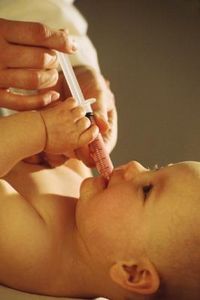
MEASURING SYRINGE
The second option is a syringe. You buy the most ordinary syringe at the pharmacy, you can immediately put the needle aside, you don’t need it, and measure the necessary dose of medicine with it. Some antipyretic drugs are also equipped with special measuring syringes, from which it is very convenient to give any liquid medicines.
DRAW THE DRUG INTO THE SYRINGE IN ADVANCEBefore you take the baby in your arms, measure the required dose of medicine in advance. If you need to dilute the drops in water, you can do this in a spoon and draw it into a syringe.
HOLD YOUR BABY CORRECTLYIf the baby is not yet sitting, this is not a reason to drink it lying down. Hold his head in the crook of your elbow as when feeding and hold his arms so that the medicine does not dislodge.
POINT THE JET ON YOUR CHEEKSlowly squeeze out the medicine, directing the jet to the cheek, and not to the throat. Do not hurry. Let the baby swallow the medicine.


